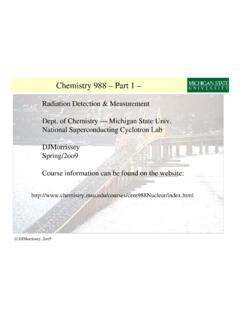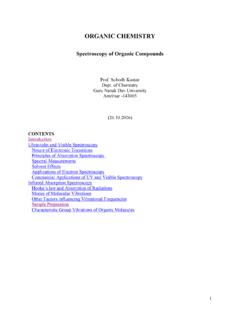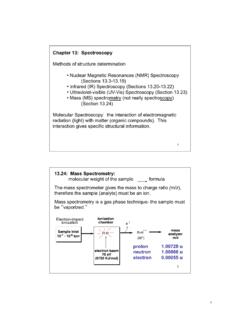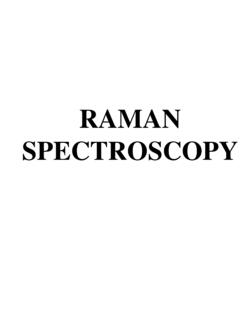Transcription of Applications of IR Spectroscopy - Chemistry
1 Dispersive vs. FTIR Instruments Chapter 17: Applications of Infrared Chapter 17: Applications of Infrared SpectroscopySpectroscopyRead: pp. 404-421 Problems: noneStructural identification of molecules + quantitative information!Identification of Structural FeaturesIdentification of Structural FeaturesQuantitative InformationQuantitative InformationA = bC= log Psolvent/PsolutionWider slit widths leads to wider bandwidths. This results in nonlinear Beer s Law behaviorSample HandlingSample Handling Solvents= water and alcohol are seldom used as they absorb strongly and attack cell window materials. Nosolventis transparent through-out the entire mid-IR region.
2 Cells= NaClor KBroften used as a transparent material sample holder. Samples= gases, liquids or solids. Pelleting(1 part sample: 1 parts KBr, press to make a transparent pellet) and mulls (dispersing solid in mineral oil).Diffuse Reflectance ModeDiffuse Reflectance ModeUseful for the study of the surface Chemistry of powder samples (R ) = (1-R )2/2R = k/sAttenuated Total ReflectanceAttenuated Total ReflectanceUseful for solids of limited solubility, films, threads, pastes, Raman Spectroscopy A spectroscopic technique used to observe vibrational, rotational, and other low-frequency modes in a system.[1] It relies on inelastic scattering, or Raman scattering, of monochromatic light, usually from a laser in the visible , near infrared, or near ultraviolet range.
3 The laser light interacts with molecular vibrations, phonons or other excitations in the system, resulting in the energy of the laser photons being shifted up or down. The shift in energy gives information about the vibrational modes in the system. Infrared Spectroscopy yields similar, but complementary, information. Light Interacting With Matter - Spectroscopy Reflection - Change in light direction at a fixed angle Transmission - Passage of light through the material, without loss of energy Absorption - Transfer of light radiation to energy within a material Scattering - Change in light direction Raman Effect Most of the light that scatters off is unchanged in energy ('Rayleigh scattered').
4 A minute fraction perhaps 1 part in 10 million has lost or gained energy ('Raman scattered'). This Raman shift occurs because photons (particles of light) exchange part of their energy with molecular vibrations in the material. Renishaw Instruments Application Areas Life Sciences (cells, tissues, micro-organisms) Materials Sciences (carbon and nanotechnology, semiconductors, catalysts) Chemical Sciences (pharmaceuticals, polymers, chemicals) Earth Sciences (geology, gemmology) Analytical Sciences (art, forensics, contaminants) Example Spectrum One plots the intensity of the scattered light (y-axis) for each energy (frequency) of light (x-axis). The frequency is traditionally measured in a unit called the wavenumber (number of waves per cm, cm-1).
5 We plot the x-axis frequencies relative to that of the laser as it is the shift in energy of the light that is of particular interest. High frequency carbon-hydrogen (C-H) vibrations in the polystyrene spectrum at about 3000 cm-1. The low frequency carbon-carbon (C-C) vibrations are at around 800 cm-1. Vibrations of two carbon atoms linked by strong double bonds (C=C) at around 1600 cm-1. This is at a higher frequency than two carbon atoms lined by a weaker single bond (C-C, 800 cm-1). C-H aromatic C-H aliphatic C=C Different Types of Raman Instruments Medical Diagnostics Process Control Images from Internet Raman Microscope and Imaging Why Use Raman Imaging?
6 Raman image of tablet used for the treatment of Parkinson's disease. You can determine: if a specific material or species is present if any unknown materials are present in the sample the variation in a parameter of a material, such as crystallinity or stress state the distribution of the material or species the size of any particles or domains the thickness and composition of layered materials the relative amounts of materials or species Renishaw Instruments Raman Spectroscopy Raman Scattering Depends on the Excitation Wavelength 1,6-dichlorohexane IR = (Parameters) Po Nd d -4 IR (photons sr-1 s-1), Po (photons s-1), (cm2 sr-1 molecule-1), Nd (molecules cm-3), d (cm), (cm)
7 Surfaced Enhanced Raman Spectroscopy Raman signals are inherently weak, especially when using visible light excitation and so a low number of scattered photons are available for detection. One method to amplify weak Raman signals is to employ surface-enhanced Raman scattering (SERS). SERS uses nanoscale roughened metal surfaces typically made of gold (Au) or silver (Ag). Laser excitation of these roughened metal nanostructures resonantly drives the surface charges creating a highly localized (plasmonic) light field. When a molecule is absorbed or lies close to the enhanced field at the surface, a large enhancement in the Raman signal can be observed. Ag nanostructures














